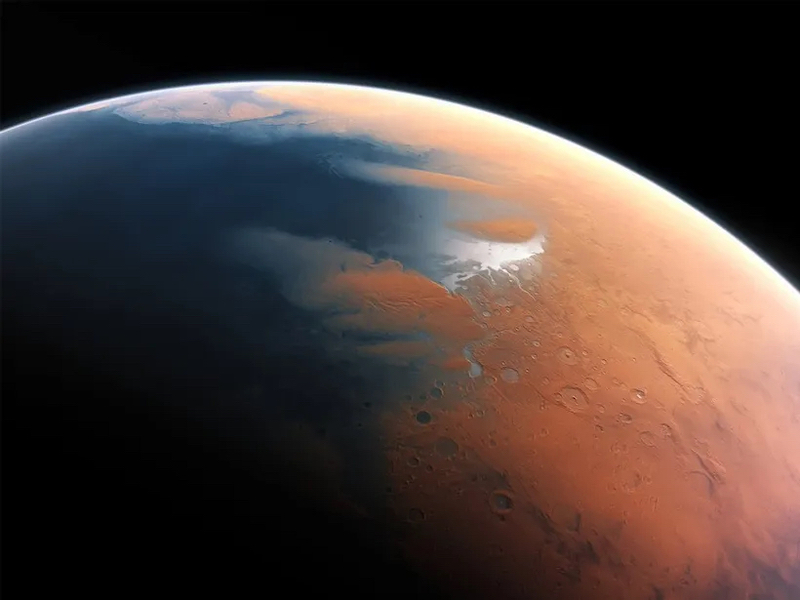
More evidence is mounting that Mars once had oceans. On October 27, 2022, researchers at Penn State and Caltech said they’ve discovered definitive traces of an old shoreline in Mars’ northern hemisphere. They developed new topographical maps, using NASA data. And they estimated the ancient Martian shoreline is some 3.5 billion years old and covers hundreds of thousands of square kilometers.
The researchers have published their peer-reviewed findings in two new papers. The first is in the Journal of Geophysical Research: Planets (October 12, 2022), and the second is in Nature Geoscience (October 27, 2022).
New topography maps shown an ancient ocean on Mars
Scientists have speculated that an ocean used to exist in the northern hemisphere lowlands on Mars. While tantalizing, the evidence hasn’t been 100% confirmed, however. As the first paper mentions:
The evidence for an ancient ocean in Mars’ northern hemispheric basin during the Noachian/Hesperian is contentious. Much of the work is based on the modern topography by assuming that erosion has not significantly reshaped the Martian surface over the last 3.5 billion years, despite evidence to the contrary.
But now, the Penn State and Caltech researchers say that they have found the most convincing evidence yet that the ocean did indeed exist. The paper continues:
Here, we provide new evidence for a northern ocean or large sea based on stratigraphic analysis of sedimentary basin fill exposed at Aeolis Dorsa.
Fluvial ridges
The scientists used software developed by the United States Geological Survey to map data from NASA and the Mars Orbiter Laser Altimeter (MOLA) on the Mars Global Surveyor (MGS) spacecraft. Mars Global Surveyor ended its mission on November 14, 2006. The team found scores of ancient fluvial ridges, over 6,500 kilometers (4,039 miles) of them, along the purported shoreline. Fluvial ridges are a type of fluvial process common on Earth that describe the motion of sediment carried in water.
The researchers estimated the sedimentary accumulation along the shoreline to be at least 900 meters (2,953 feet) thick. The researchers grouped the ridges into 20 different systems for the study. The results show that, indeed, they are likely eroded river deltas or submarine-channel belts. Lead author Benjamin Cardenas at Penn State said:
The big, novel thing that we did in this paper was think about Mars in terms of its stratigraphy and its sedimentary record. On Earth, we chart the history of waterways by looking at sediment that is deposited over time. We call that stratigraphy, the idea that water transports sediment and you can measure the changes on Earth by understanding the way that sediment piles up. That’s what we’ve done here, but it’s Mars.
The stratigraphy that we’re interpreting here is quite similar to stratigraphy on Earth. Yes, it sounds like a big claim to say we’ve discovered records of large waterways on Mars, but in reality, this is relatively mundane stratigraphy. It’s textbook geology once you recognize it for what it is. The interesting part, of course, is it’s on Mars.
Was Aeolis Dorsa the ancient ocean on Mars?
The fluvial ridges are located in a region called Aeolis Dorsa. This region, about 500 kilometers (311 miles) wide and 900 kilometers (560 miles) long, contains the highest density of such ridges on the entire planet. Cardenas said:
The rocks in Aeolis Dorsa capture some fascinating information about what the ocean was like. It was dynamic. The sea level rose significantly. Rocks were being deposited along its basins at a fast rate. There was a lot of change happening here.
Moreover, the scientists say that the sea level at the time was consistent with a world that was warm and wet for an extended period of time.

A higher potential for life
Of course, if there were a huge ocean on Mars, then that raises the question of life. Could that ocean have been inhabited, at least by microbes? Cardenas commented on this, saying:
What immediately comes to mind as one the most significant points here is that the existence of an ocean of this size means a higher potential for life. It also tells us about the ancient climate and its evolution. Based on these findings, we know there had to have been a period when it was warm enough and the atmosphere was thick enough to support this much liquid water at one time.
A major goal for the Mars Curiosity rover missions is to look for signs of life. It’s always been looking for water, for traces of habitable life. This is the biggest one yet. It’s a giant body of water, fed by sediments coming from the highlands, presumably carrying nutrients. If there were tides on ancient Mars, they would have been here, gently bringing in and out water. This is exactly the type of place where ancient Martian life could have evolved.
In another recent study from last month, scientists said that Mars not only likely had an ocean, but that it had one before Earth did. In fact, Mars was already a water world while Earth was still forming.
Bottom line: Scientists said they have confirmed an ancient ocean on Mars. The study uses new topographical maps that reveal traces of the shoreline that once existed.
Source: Martian landscapes of fluvial ridges carved from ancient sedimentary basin fill











